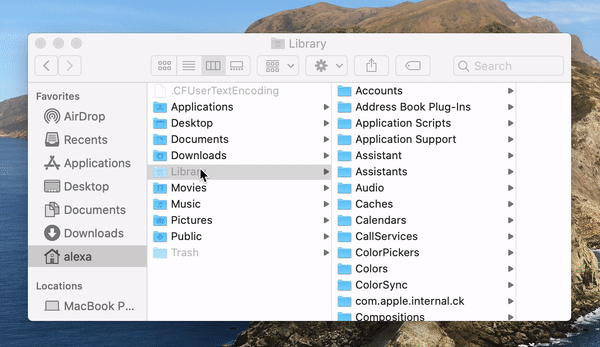
- #How to get the library folder on mac software#
- #How to get the library folder on mac mac#
- #How to get the library folder on mac windows#
Remove personal data that’s stored by sites or apps.
#How to get the library folder on mac mac#
And remember, a clean Mac is a faster Mac. That’s why regularly clearing the cache is a great way to help clean up your Mac. If you’ve never cleaned out your caches, you may have gigabytes of unnecessary files taking up space on your machine. That’s a lot of images and videos stored on your computer, and you probably won’t give most of those sites a second glance.Īnd that’s just your browser cache - there’s also your system and application caches. Consider for a moment every website you’ve ever visited online - every eshop, every social media profile, every search. While cached files help images and other on-page elements load a bit faster when you revisit familiar sites, you don’t usually need the stored data in the cache. But is it a good idea to get rid of all those cached files? What does clearing cached data do?Ĭlearing your cache deletes unnecessary data and frees up disk space. There are three main types of caches: browser cache, system cache, and application cache (also called user cache). Even Apple’s own apps, such as Spotlight and Maps, and macOS itself store cached files.
#How to get the library folder on mac software#
Other apps such as photo and video editing software also create cached data. It’s not only your browser that stores cached files. This will immediately take you to the Library Folder on your Mac.How to Clear Your Cache on a Mac or MacBook | Avast Logo Ameba Icon Security Icon Security White Icon Privacy Icon Performance Icon Privacy Icon Security Icon Performance Icons/45/01 Security/Other-Threats Icons / 32 / Bloatware removal Icons / 32 / Registry Cleaner Icons / 32 / CleanUp Icons / Feature / 32 / Mac Icons / 32 / Browser cleanup Icons/32/01 Security/Malware Icons/32/01 Security/Viruses Icons/32/01 Security/Other-Threats Icons/32/01 Security/Passwords Icons/32/01 Security/Ransomware Icons/32/01 Security/Business Icons/32/02 Privacy/Browser Icons/32/02 Privacy/IP adress Icons/32/02 Privacy/VPN Icons/32/02 Privacy/Proxy Icons/32/02 Privacy/Streaming Icons/32/03 Performance/Celaning Icons/32/03 Performance/Drivers Icons/32/03 Performance/Gaming Icons/32/03 Performance/Hardware Icons/32/03 Performance/Speed Icons / 32 / Bloatware removal Icons / 32 / Registry Cleaner Win Icons / 32 / CleanUp Icons / Feature / 32 / Mac Icons / 32 / Browser cleanup Icons/60/02 Privacy/02_Privacy Icons/60/01 Security/01_Security Icons/60/03 Performance/03_Performance Icons/80/01 Security/IoT Icons/80/01 Security/Malware Icons/80/01 Security/Passwords Icons/80/01 Security/Ransomware Icons/80/01 Security/Viruses Icons/80/01 Security/Other-Threats Icons/80/03 Security/Business Icons/80/02 Privacy/Browser Icons/80/02 Privacy/IP adress Icons/80/02 Privacy/VPN Icons/80/02 Privacy/Proxy Icons/80/02 Privacy/Streaming Icons/80/03 Performance/Celaning Icons/80/03 Performance/Drivers Icons/80/03 Performance/Gaming Icons/80/03 Performance/Hardware Icons/80/03 Performance/Speed Icons/80/03 Performance/03_Performance Icons/80/02 Privacy/02_Privacy In Go to Folder window, type ~/Library, and click on the Go button. Open Library Folder On Mac Using “Go to Folder” OptionĪnother way to Open the Library Folder on Mac is by using the Go to Folder option, as available in macOS.Ĭlick on Finder Icon > select the Go tab in top-menu bar and click on Go to Folder… option in the drop-down menu.

#How to get the library folder on mac windows#
Note: Press the Alt Key in case you are using an external Windows keyboard with your Mac.Ĭlicking on the Library Menu option will take you straight to the Library Folder on your Mac.

Open Library Folder on Mac Using Option KeyĬlick on the Finder Icon > press and hold the Option key on the keyboard > select Go tab in top-menu bar and click on the Library option that becomes available in the drop-down menu. Hence, it is good idea to be familiar with the steps to Access the Hidden Library Menu and Open the Library Folder on your Mac. While you may not currently find any need to Open Library Folder, you will find the need to Access Library the Folder for troubleshooting purposes.


 0 kommentar(er)
0 kommentar(er)
